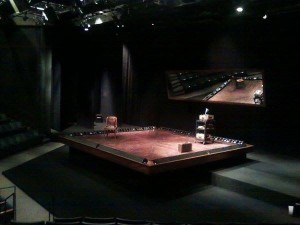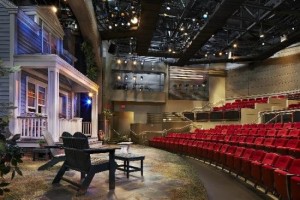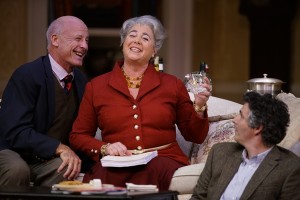 “We feel first; and then with the advice and consent of whatever the feeling is, we think or think we think. I say think we think because I can’t but observe the thinking’s seldom more than an inventing of arguments in favor of the feeling.”
“We feel first; and then with the advice and consent of whatever the feeling is, we think or think we think. I say think we think because I can’t but observe the thinking’s seldom more than an inventing of arguments in favor of the feeling.”
James Gould Cozzens, By Love Possessed

 Gordon’s Satchmo, whose set was designed by Lee Savage, is for the most part naturalistic in approach. It takes place in a dressing room that is specifically intended to suggest a room at New York’s Waldorf-Astoria Hotel, in whose Empire Room Louis Armstrong played his last gig in March of 1971, four months before his death. As part of his preparation for designing the set, Lee studied period photographs of the Waldorf, and he made every possible effort to create a performing space that has “Waldorf ” written all over it, right down to the tiniest of details. Armstrong’s dressing-room table is strewn with objects closely similar to the ones that can be seen in surviving photographs of his real-life dressing rooms and hotel rooms, and John Gromada, the sound designer, accompanied the production with a well-chosen selection of excerpts from Armstrong’s recordings. The goal was to make Satchmo look and sound as realistic as possible, and I think we succeeded. The sink even works!
Gordon’s Satchmo, whose set was designed by Lee Savage, is for the most part naturalistic in approach. It takes place in a dressing room that is specifically intended to suggest a room at New York’s Waldorf-Astoria Hotel, in whose Empire Room Louis Armstrong played his last gig in March of 1971, four months before his death. As part of his preparation for designing the set, Lee studied period photographs of the Waldorf, and he made every possible effort to create a performing space that has “Waldorf ” written all over it, right down to the tiniest of details. Armstrong’s dressing-room table is strewn with objects closely similar to the ones that can be seen in surviving photographs of his real-life dressing rooms and hotel rooms, and John Gromada, the sound designer, accompanied the production with a well-chosen selection of excerpts from Armstrong’s recordings. The goal was to make Satchmo look and sound as realistic as possible, and I think we succeeded. The sink even works! Charlie’s production of Satchmo, whose set was designed by John Culbert, is as expressionistic as Gordon’s production is naturalistic. It takes place on an elevated, all-but-bare playing area that is surrounded on all four sides by footlights. A huge upstage mirror is carefully positioned to reflect the onstage action in a way that is visible to everyone in the audience. Keith Parham’s sharp-angled lighting is unabashedly theatrical—his use of shadows is straight out of film noir—and Andre Pluess, the sound designer, has accompanied the show with a thickly layered mix of recordings by Armstrong, electronic music, and sound effects, some of them realistic and others almost hallucinatory. In a sense, the sound is the scenery: it hints at where we are and what is happening there.
Charlie’s production of Satchmo, whose set was designed by John Culbert, is as expressionistic as Gordon’s production is naturalistic. It takes place on an elevated, all-but-bare playing area that is surrounded on all four sides by footlights. A huge upstage mirror is carefully positioned to reflect the onstage action in a way that is visible to everyone in the audience. Keith Parham’s sharp-angled lighting is unabashedly theatrical—his use of shadows is straight out of film noir—and Andre Pluess, the sound designer, has accompanied the show with a thickly layered mix of recordings by Armstrong, electronic music, and sound effects, some of them realistic and others almost hallucinatory. In a sense, the sound is the scenery: it hints at where we are and what is happening there. All this is of particular relevance to me because I’ll be
All this is of particular relevance to me because I’ll be  And how well will that work? Your guess is as good as mine. But I do know that whatever its ultimate value as a play, Satchmo at the Waldorf has so far proved strong enough to have inspired two full-scale productions that are radically different in appearance and approach, as well as a small-scale version, the 2011 Orlando premiere, that was directed by Rus Blackwell and designed by William Elliot. Staged in a tiny cabaret-style black-box theater, the first Satchmo presented the show in a much more intimate (but similarly convincing) manner.
And how well will that work? Your guess is as good as mine. But I do know that whatever its ultimate value as a play, Satchmo at the Waldorf has so far proved strong enough to have inspired two full-scale productions that are radically different in appearance and approach, as well as a small-scale version, the 2011 Orlando premiere, that was directed by Rus Blackwell and designed by William Elliot. Staged in a tiny cabaret-style black-box theater, the first Satchmo presented the show in a much more intimate (but similarly convincing) manner. The final dress rehearsal for the first preview of the Court Theatre’s
The final dress rehearsal for the first preview of the Court Theatre’s  The real problem, I think, is that I can’t quite grasp that Satchmo has—and, I hope, will continue to have—a life without me. Yes, I did my best to be helpful to Charlie Newell and Barry Shabaka Henley, the director and star of the Court Theater’s production of Satchmo, but I know that the Court could have produced the show perfectly well had I stayed home. Once we opened in New York in 2014 and I signed off on the
The real problem, I think, is that I can’t quite grasp that Satchmo has—and, I hope, will continue to have—a life without me. Yes, I did my best to be helpful to Charlie Newell and Barry Shabaka Henley, the director and star of the Court Theater’s production of Satchmo, but I know that the Court could have produced the show perfectly well had I stayed home. Once we opened in New York in 2014 and I signed off on the  I won’t deny, though, that I also went to Chicago just for the fun of it. My three operatic collaborations with Paul Moravec taught me that there are few things in the world more purely pleasurable than rehearsing a show, and having finally gotten around to writing a play on the eve of my late middle age, I’m well aware that I won’t get anything remotely approaching an unlimited number of opportunities to repeat the experience. That being the case, I figure I’d better squeeze all the juice I can out of this one. Nobody has to tell me that the clock is running.
I won’t deny, though, that I also went to Chicago just for the fun of it. My three operatic collaborations with Paul Moravec taught me that there are few things in the world more purely pleasurable than rehearsing a show, and having finally gotten around to writing a play on the eve of my late middle age, I’m well aware that I won’t get anything remotely approaching an unlimited number of opportunities to repeat the experience. That being the case, I figure I’d better squeeze all the juice I can out of this one. Nobody has to tell me that the clock is running.
 First performed in 1988, “The Cocktail Hour” is a more-or-less autobiographical comedy about John (Brendan Powers), a youngish playwright who comes home to Buffalo, the city where he (and Mr. Gurney) grew up, with a surprise up his sleeve for his priggish parents: His new play is all about them. The title? “The Cocktail Hour,” naturally—and it’s not a wholly affectionate portrait, either….
First performed in 1988, “The Cocktail Hour” is a more-or-less autobiographical comedy about John (Brendan Powers), a youngish playwright who comes home to Buffalo, the city where he (and Mr. Gurney) grew up, with a surprise up his sleeve for his priggish parents: His new play is all about them. The title? “The Cocktail Hour,” naturally—and it’s not a wholly affectionate portrait, either…. I wrote a piece about Harold Arlen for the latest issue of the Weekly Standard:
I wrote a piece about Harold Arlen for the latest issue of the Weekly Standard: